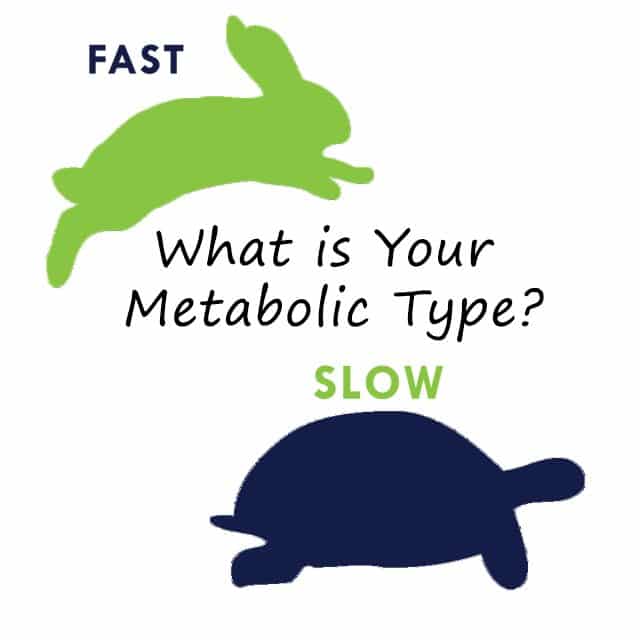Your metabolism can tell you as much about how your body functions as the Myers Briggs test will tell you about your personality type. There are 8 different metabolism types that you may fall under and while it is possible to change your type over time, it is likely easier to adjust your diet and exercise plan to reach whatever physical goals you may have based off your specific type of metabolism.
Understanding the Balancing Act: Fast – Slow
The 8 types are broken down into two categories, fast or slow and each category has types 1-4 respectively. It is important to note that the ‘perfect’ metabolic type does not exist. You will normally fluctuate on this scale, always being either fast or slow.

If you picture a seesaw type 4 of each fast and slow would be on the outer edges. Working towards the center types 3 and 2 would come next. Types 1 of each would be as close to the center point as they can be without being dead center – essentially the closest you can get to achieving an ideal balance between the sympathetic and parasympathetic systems.
Discussing the characteristics of fast and slow, you will see similarities across the types of each category.
Fast – Slow : Parasympathetic – Sympathetic
Slow metabolizers have a parasympathetic dominance. Your parasympathetic system has a larger influence on resting, nourishing and repairing throughout the body. Fast metabolizers have a sympathetic dominance, which has an opposite effect on the body, speeding up the body’s processes. Fast and slow metabolizers are also fast and slow oxidizers respectively. A fast oxidizer will quickly turn food into energy while a slow oxidizer will metabolize at a much slower pace.
Fast metabolizers will also tend to have an increased thyroid and adrenal function. This can show up as high body temperature, sweating often, having a hard time focusing on one thing at a time leading to procrastination, being prone to stress, and having a hard time winding down at the end of the day.
Slow metabolizers tend to have decreased thyroid and adrenal function. This can show up as lower energy levels, making you feel overly fatigued day-to-day. There can also be reduced blood flow in the body, overworked parathyroid and pancreatic hormones, and feelings of dizziness if standing up too fast. Slow metabolizers have an easier time than fast metabolizers focusing on one thing at a time, but may be more apt to become perfectionists when trying to complete a task.
Fast metabolizers show more signs of potentially developing substance abuse issues, while slow metabolizers are more prone to feeling down or having lower self-esteem, as they tend to dwell on the past and have a hard time expressing emotions.
A Closer Look At The Metabolic Types
The slight differences that you will see within the 8 types are as follows:
- Fast Type #1: Thyroid/Adrenal Dominance
- Slow Type #1: Decreased Thyroid/Adrenal Function
- Fast/Slow Type #2: Adrenal Dominance
- Fast/Slow Type #3: Thyroid Dominance
- Fast Type #4: Decreased Thyroid/Adrenal Function
- Slow Type #4: Thyroid/Adrenal Dominance
Fast and Slow Type #1 metabolizers are considered synchronized because both the thyroid and adrenal function are the same and fall under the characteristics of the parasympathetic and/or sympathetic dominance that ‘rules’ each category. All other types are considered out of sync.
Humans are typically born with a fast metabolism, despite their genetics. It is over time that our bodies metabolism type will change based off eating and exercise patterns. There are two parts that make up your metabolism, catabolism and anabolism. Catabolism is the rate at which your body breaks down compounds to release energy and anabolism is the rate at which your body builds up compounds to utilize the energy. Catabolism will provide energy for physical activity, cellular processes and body movement, while anabolism will allow for the build up of muscle mass, growth and mineralization of bone and the growth of new cells. If you are producing more energy than you are using, your body will store it as fat, and you may experience weight gain.

Learning your metabolism type can be done through mineral hair analysis testing or potentially by speaking to your doctor for other specialized tests.
It is not enough to look at your body type to determine your metabolism. Smaller body types do not always have a fast metabolism, in fact it usually quite the opposite! Larger body types are prone to faster metabolism because they require more energy for the body to function. It is also a myth that your metabolism slows as you age, while it may change over time that would be the result of a dramatic lifestyle change more so than aging. Also, depending on your metabolism the theory that eating up to six smaller meals a day to boost metabolism may not be true for you. So, take out the guesswork and learn your metabolic type.
At the end of the day, learning more about your metabolism type will help you have a better understanding of your body’s processes. With this understanding, you will be able to discover the best foods for you, as well as optimal exercise programs to help you reach your physical goals. It is extremely hard, if not impossible, to change your metabolic type, so it is important to not set unrealistic goals and work with your body instead of against it.

